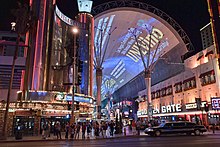
A road verge is a strip of grass or plants, and sometimes also trees, located between a roadway (carriageway) and a sidewalk (pavement). Verges are known by dozens of other names, often quite regional; see Terminology below.

A street is a public thoroughfare in a built environment. It is a public parcel of land adjoining buildings in an urban context, on which people may freely assemble, interact, and move about. A street can be as simple as a level patch of dirt, but is more often paved with a hard, durable surface such as tarmac, concrete, cobblestone or brick. Portions may also be smoothed with asphalt, embedded with rails, or otherwise prepared to accommodate non-pedestrian traffic.
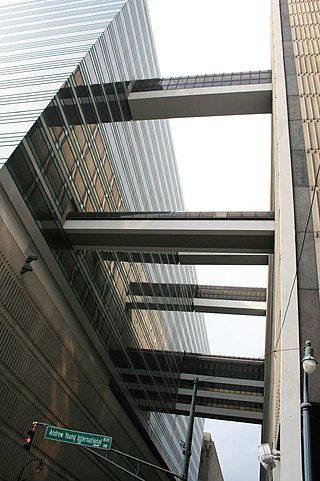
A skyway, skybridge, skywalk, or sky walkway is an elevated type of pedway connecting two or more buildings in an urban area, or connecting elevated points within mountainous recreational zones. Urban skyways very often take the form of enclosed or covered footbridges that protect pedestrians from the weather. Open-top modern skyways in mountains now often have glass bottoms. Sometimes enclosed urban skywalks are made almost totally from glass, including ceilings, walls and floors. Also, some urban skyways function strictly as linear parks designed for walking.

A shopping mall is a North American term for a large indoor shopping center, usually anchored by department stores. The term "mall" originally meant a pedestrian promenade with shops along it, but in the late 1960s, it began to be used as a generic term for the large enclosed shopping centers that were becoming commonplace at the time. In the U.K., such complexes are considered shopping centres, though "shopping center" covers many more sizes and types of centers than the North American "mall". Other countries may follow U.S. usage while still others follow U.K. usage. In Canadian English, and often in Australia and New Zealand, the term 'mall' may be used informally but 'shopping centre' or merely 'centre' will feature in the name of the complex. The term 'mall' is less-commonly a part of the name of the complex.
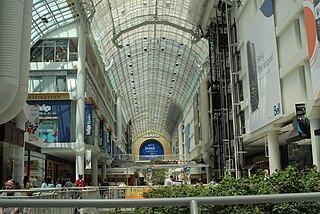
A shopping center, shopping centre or shopping mall, also called a shopping complex, shopping arcade, shopping plaza or galleria, is a group of shops built together, sometimes under one roof.

Pedestrian zones are areas of a city or town reserved for pedestrian-only use and in which most or all automobile traffic is prohibited. Converting a street or an area to pedestrian-only use is called pedestrianisation.

Victor David Gruen, born Viktor David Grünbaum, was an Austrian-American architect best known as a pioneer in the design of shopping malls in the United States. He is also noted for his urban revitalization proposals, described in his writings and applied in master plans such as for Fort Worth, Texas (1955), Kalamazoo, Michigan (1958) and Fresno, California (1965). An advocate of prioritizing pedestrians over cars in urban cores, he was also the designer of the first outdoor pedestrian mall in the United States, the Kalamazoo Mall.
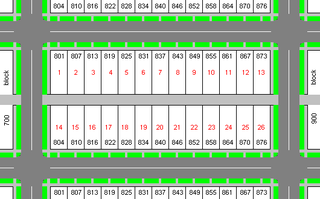
A city block, residential block, urban block, or simply block is a central element of urban planning and urban design.

Los Angeles has a complex multimodal transportation infrastructure, which serves as a regional, national and international hub for passenger and freight traffic. The system includes the United States' largest port complex; an extensive freight and passenger rail infrastructure, including light rail lines and rapid transit lines; numerous airports and bus lines; vehicle for hire companies; and an extensive freeway and road system. People in Los Angeles rely on cars as the dominant mode of transportation, but since 1990 the Los Angeles County Metropolitan Transportation Authority has built over one hundred miles (160 km) of light and heavy rail serving more and more parts of Los Angeles and the greater area of Los Angeles County. As a result, Los Angeles was the last major city in the United States to get a permanent rail system installed.

The Third Street Promenade is a pedestrian mall esplanade, shopping, dining and entertainment complex in the downtown area of Santa Monica, California which originally opened as the Santa Monica Mall on November 8, 1965. It is considered a premier shopping and dining district on the Westside and draws crowds from all over the Greater Los Angeles area. Due to easy access to Downtown Los Angeles via the Big Blue Bus rapid transit service, E Line's terminus station and the Pacific Coast Highway-Santa Monica Freeway Interstate, the neighborhood's north-south thoroughfares connecting to Muscle Beach, Venice Canal Historic District, Marina del Rey, Ballona Wetlands and Los Angeles International Airport, and its proximity to historic U.S. Route 66, Santa Monica Pier, Palisades Park, Tongva Park, Santa Monica State Beach and the Pacific Ocean coupled with Los Angeles's mild mediterranean climate, it is also a popular tourist destination.
Central Atlanta Progress (CAP), founded in 1941, as the Central Area Improvement Association, is a private, not-for-profit corporation, chartered to plan and promote Atlanta's Central Area, that strives to create a robust economic climate for downtown Atlanta, Georgia, in the United States.
The Hahn Company, San Diego, California, alternately known as Ernest W. Hahn, Inc., was a major American shopping center owner and developer from the 1950s to the 1980s. Purchased by the Trizec Corp. in 1980, it became defunct.

A transit mall is a street, or set of streets, in a city or town along which automobile traffic is prohibited or greatly restricted and only public transit vehicles, bicycles, and pedestrians, and emergency services are permitted.
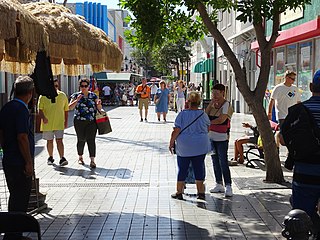
Paseo Atocha is a pedestrian shopping mall in the Ponce Historic Zone, a historic district in Ponce, Puerto Rico. For over a century the narrow Calle Atocha was bustling retail center opened to vehicular traffic, yet flooded with shoppers. Congestion and pedestrian safety led the municipal government to close the two blocks of Calle Atocha from Calle Isabel to Calle Vives to motor vehicles in 1991. Several years later, the closure was expanded to include the block from Calle Vives to Calle Victoria. This last segment coincides with the western perimeter of the historic Plaza de Mercado Isabel II city market. Not the bustling commercial spot it once was, today it is still actively frequented by shoppers, though in much reduced numbers. It is visited annually by thousands of locals and tourists alike and is considered one of the city’s main places of interest.

The Kalamazoo Mall, the first outdoor pedestrian shopping mall in the United States, is a section of Burdick Street in downtown Kalamazoo, Michigan.

ROMA Design Group is an interdisciplinary firm of architects, landscape architects, and urban planners based in San Francisco, California, USA. It was founded in 1968 by American architect George T. Rockrise.

The Fulton Mall was a six-block corridor in downtown Fresno, California which was closed to traffic in 1964 and made into a pedestrians only mall. Despite opening to much fanfare, the downtown mall suffered from the city's suburban expansion, especially the opening of the Fashion Fair Mall six miles to the north. By the 1980s, most storefronts on the mall were empty and plans to renovate the mall were discussed. In 2017, car traffic was reintroduced to the street after most of the public art and amenities had been relocated to sidewalk areas.
The Eugene Mall was a car-free zone in the heart of Eugene, Oregon, United States, designed to encourage pedestrian access to shopping and entertainment areas. Dedicated on February 13, 1971, the mall opened amid three days of fanfare and dreams of a revitalized downtown. Conflict over the scope and use of the mall began immediately and continued for 30 years until the last remaining parts of the mall were opened to automobile traffic. At that time, a former Eugene mayor commented that the city's dreams for a bright future just hadn't worked. Many residents, however, shared the much-earlier view of a former downtown merchant, that Eugene had sustained more damage from the mall than it would have from a natural disaster.

Tactical urbanism, also commonly referred to as guerrilla urbanism, pop-up urbanism, city repair, D.I.Y. urbanism, planning-by-doing, urban acupuncture, and urban prototyping, is a low-cost, temporary change to the built environment, usually in cities, intended to improve local neighbourhoods and city gathering places.



